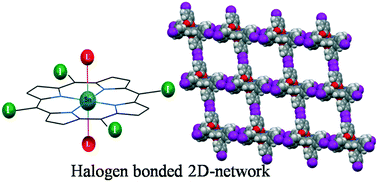Wheel-and-axle topology-driven halogen bonds: formation of ladder, 1D and 2D networks in hexa-coordinated Sn(iv) porphyrins†
Abstract
The present study is devoted towards the construction of metalloporphyrin assemblies directed and sustained by halogen bonds (XBs) on judiciously selected molecular scaffolds. We choose a series of Sn(axial-L)2–(5,10,15,20-tetraiodoporphyrin) [Sn(L)2–TIPP, where L = halogen/nitro-substituted benzoate moiety] complexes as our building units that resemble a ‘wheel and axle’ topology aiding the construction of different types of molecular assemblies like ladder, 1D and 2D networks. In all the complexes explored herein, the wheel is constructed with Sn(IV)–5,10,15,20-meso-tetrakis(4-iodophenyl)porphyrin [Sn(L)2–TIPP], which is rigid and the two pairs of iodine atoms present at the meso-phenyl position of the porphyrin ring can get involved in XB interactions, depending upon the complementary interacting atoms present at the axle. Single crystal X-ray diffraction analysis confirms the occurrence of halogen bonds in crystalline metalloporphyrin assemblies via I⋯I, I⋯O and I⋯π halogen bonds. Most interestingly, these XBs are not only restricted between wheel⋯axle alone, but can also occur between wheel⋯wheel and axle⋯axle. Different types of XB-directed molecular associations are observed, for example, ladder-type supramolecular associations occur in 1, 2D-networks in 2, 3 and 8, interlinked 1D networks in 4 and 5, and 1D-networks in 7. Theoretical studies with Hirshfeld surface analysis show the definite role of XB interactions in the overall stability of the complexes. Electrostatic potential surface studies with the aid of density functional theory (DFT) in 2 and 8 show the presence of a σ-hole on the cap of the iodine atom which further augments the role of XBs in the observed architectures. The structural and theoretical studies presented here showcase that it is necessary to consider an adequate topology such as that of a ‘wheel and axle’ along with complementary interacting functional groups placed adequately on hexa-coordinated Sn(IV)–porphyrins to realize molecular constructions such as ladder, 1D and 2D networks.

- This article is part of the themed collection: 1st International Conference on Noncovalent Interactions


 Please wait while we load your content...
Please wait while we load your content...